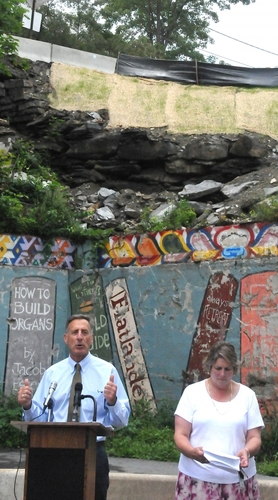BRATTLEBORO — The Green Street retaining wall project, estimated to cost $585,000, received an injection of funds Tuesday.
Gov. Peter Shumlin announced a $300,000 Community Development Block Grant (CDBG) for the town during a press conference in the Harmony Parking Lot.
Federal CDBG funds help finance housing, support job creation, preserve cultural heritage, and rebuild infrastructure.
Communities apply for grants, which are funneled from the feds to state agencies.
The town closed the one-way portion of Green Street, Green Street Extension, last fall after the 200-foot-long retaining wall showed signs of deterioration. A wide crack had formed in the road as the wall tilted outward toward the Harmony Parking Lot.
“The tallest middle section of the stone wall is leaning out by several feet and continues to move,” wrote Director of Public Works Steve Barrett in a memo. “It is, in our opinion, close to failure.”
Repairing the wall is estimated to cost $585,000.
Federal funds help the state
This latest round of CDBG funds brought $2.8 million into the state, said Shumlin.
Other projects to receive the grants include moving a child-care facility in Tunbridge out of the flood plain, building affordable senior housing in Milton, updating safety systems in a museum in Proctor, purchasing a mobile-home park in Randolph, supporting homebuyers in the Northeast Kingdom, developing an industrial park in Bristol, and building 26 affordable-housing units in Bennington.
Shumlin pointed to the renovated Brooks House as an example of the power of public investment in infrastructure. A five-alarm fire ravaged the historic structure in 2011. The building, reopened last year after an extensive rebuild, now houses retail stores, restaurants, apartments, and two state colleges.
George Twigg, state director for U.S. Representative Peter Welch, also said CDBG grants represent a good investment for taxpayers.
Noting that each tax dollar invested into CDBG funds leverages $4 in other funds, a vibrant downtown like Brattleboro's “can't happen if we don't invest in infrastructure,” Shumlin said.
He thanked Vermont's congressional delegation for helping bring federal funds to the state.
Vermont has made great progress in improving its infrastructure over the last five years, said Shumlin, adding that he's proud of the progress that the state has made since he was elected in 2010.
The state has cut by half the number of derelict bridges and poorly paved roads, he said.
Tropical Storm Irene helped the state rehabilitate its declining infrastructure on two levels, said Shumlin. First, the storm provided an influx of federal dollars. Second, it helped break down isolated efforts between agencies at the state and local levels.
New, more efficient partnerships have replaced these silos, he said.
Secretary of Transportation Sue Minter said that the state has developed innovative, more efficient methods of repairing roads and bridges, methods that help keep costs down while getting more projects done.
For example, instead of building a temporary bridge while spending two years replacing the old bridge, she said, the contractors keep the old bridge open while building a new bridge nearby over three weeks.
